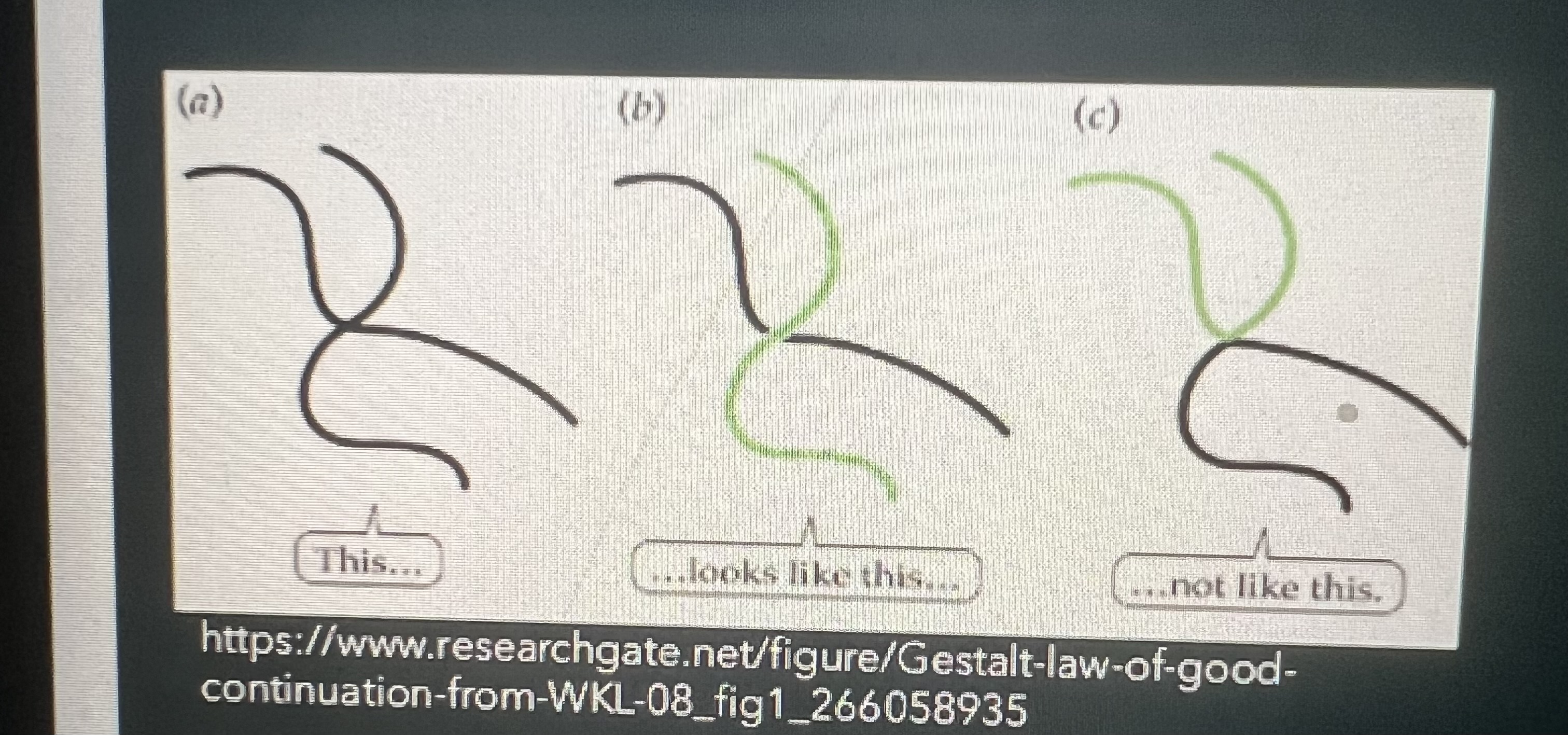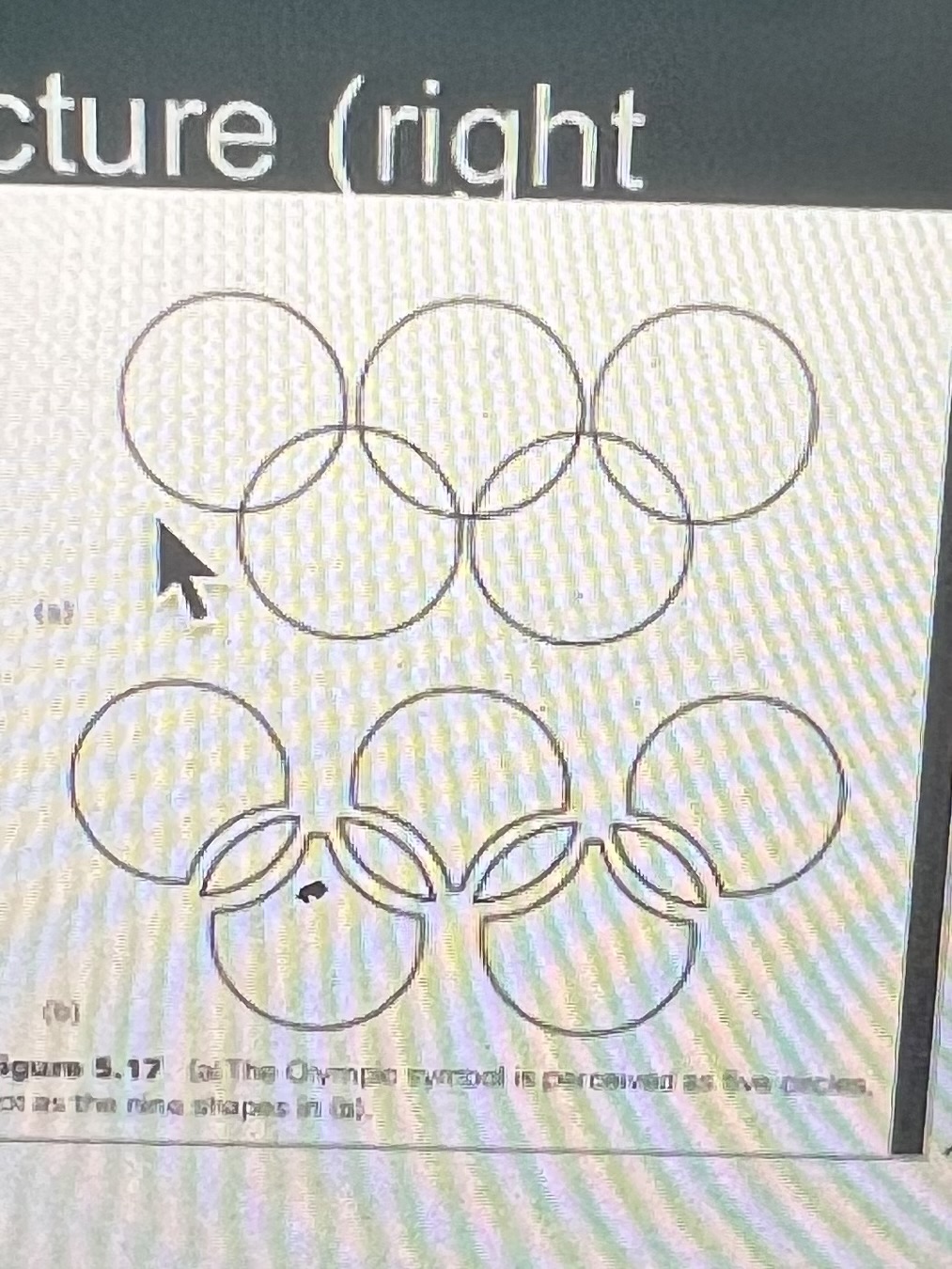Sensation/Perception Exam 1
1/74
There's no tags or description
Looks like no tags are added yet.
Name | Mastery | Learn | Test | Matching | Spaced |
|---|
No study sessions yet.
75 Terms
sensation
Early, basic steps in the perceptual process (when light reaches the eye)
Perception
The experiences that result from stimulation of the senses
Principle of transformation
The stimulus is transformed by the perceptual process
Príncipe of representation
Perception is based on a series of representations on our receptors rather than direct contact with the stimulus (what we perceive doesn’t perfectly represent the world)
Simplified perceptual process
Stimulus (proximal/distal) 2. Physiology (processing, receptors) 3. Behavior (perception, recognition, action)
Distal stimulus
Stimulus in our environment
Proximal stimulus
When distal stimulus is represented on sensory receptors, it becomes the proximal stimulus
Transduction
Changing environmental energy (signal) to electrical energy (signal)
Olfaction
A chemosensory perception. We are taking in a chemical
Olfactory receptor neurons
Sensitive to specific odors and located toward back of nose (350-400 types and 10,000 of each type)
Odor detection
Seeing if you can smell something at a certain distance
Odor valence
Pleasantness or unpleasantness of smell (memories can affect this)
Odor detection thresholds
You need different amounts of an odor object to detect it. Different people have different thresholds
Olfaction memory
After repeated exposure to certain odors, certain molecules may be activated (the chemo topic map) in sync (scattered activation) within the piriform cortex and a pattern for each smell emerges
Proust effect
Certain odors are strong autobiographical memory triggers. Often stronger than visual cueing. Related to the proximity/connections with the amygdala and hippocampus (emotions;memories)
PTSD (olfaction)
Heightened sensitivity to fear associated odors (burning tires). Less sensitive to neutral odors. Smell exposure therapy can help
Can you improve smell perception?
Yes with sommelier classes
Anosmia and it’s consequences
Loss of smell can cause loss of appetite, safety hazards (can’t detect gas), difficulty tracking hygiene, loss of pleasured, decrease quality of life
Hyposnia
Reduced sense of smell
Groups at risk for poor smell
Smokers, cancer/being treated for it, psychosis, TBI, illness (COVID)
Alzheimer’s Disease (olfaction)
Problems with memory/familiarity of smells and not so much the processing of smells. People’s brains with risk factor APOE gene had to work harder in olfactory test
Parkinson’s’s Disease
Olfactory dysfunction can be a common symptom even years before motor symptoms
Judging the unpleasantness of an odor object is an example of
valence
Individuals with this illness will most likely have difficulty remembering smells even if they were once familiar to them
Alzheimer’s disease
There are more types of olfactory receptors neurons than glomeruli
True
By the time the olfactory signal reaches a glomerulus, it is already an electrical signal
True
Gustation
Taste. A chemosensory perception.
What are the 5 basic taste sensations?
Sweet, salty, bitter, sour, umami (meaty)
Taste buds
Papillae contain taste buds except for the filiform papillae. Abt 10,000 taste buds on tongue with each one having 50-100 taste receptor cells for each of the 5 tastes. Their life cycle is 1-2 weeks
Filiform papillae
the tip of the tongue. Doesn’t have tastebuds and helps move food around
Circumvallate papillae
Tend to have more bitter taste receptor cells which is important to detect toxic foods
Hippocampus and amygdala (gustation)
Can trigger responses to tastes (salivation, gagging) can help regulate eating behaviors
Orbito frontal cortex (gustation)
Helps us evaluate valence (pleasant/unpleasantness) of what we are eating and evaluates our sensory specific satiety which determines when we get tired of certain tastes (ex: when we want sweets after savory meal)
Taster status
Can be discovered by counting papillae, chemical PROP. Non tasters more open to bitter things like black coffee
Oral capture
Perception that taste is only experienced in the mouth. exception is monosodium glutamate (MSG)
Factors that can influence flavor perception
Smell, culture, texture, vision (packaging, red color usually cherry), social atmosphere (more likely to try a food if ppl around you are), expectations (lower activation of orbitofrontal cortex with $10 bottle of wine and higher with expensive wine), sensory specific satiety
Changes in flavor preferences
Can be due to head injuries. Behavioral variant frontotemporal dementia involves shrinkage in prefrontal/orbitofrontal areas causing more sweet cravings
Other applications of gustation
Pest control, punishment and safety for kids (bitter nail taste for nail biting), alcohol use disorders (thing that makes alcohol taste bitter and makes the person vomit), flavor development (marketing)
Spice
NOT a taste or flavor. It’s a pain reaction
Presbyopia from normal aging
Ciliary muscles become weaker, lens hardens and is less flexible which results in difficulty focusing on objects in a close range
Hyperopia
Farsightedness. Difficulty seeing nearby objects, eyeball is too short
Myopia
Nearsightedness. Difficulty seeing distant objects, light is bent too much by cornea/lens or eyeball is too long
Visual receptors
Photoreceptors. Involves rods and cones
Rods
many more rods than cones (abt 120 million vs 6 million). In peripheral retina. Does not perceive color. Helps in dim environments
Cones
There are only cones in the fovea but most cones are in the peripheral retina (outside of fovea)
fovea
Very detailed, focused images from the cones
Macular degeneration
Degeneration of fovea. Central focus point is blurry, they mostly see peripherally
Retinitis pigmentosa
Degeneration of peripheral retina. Attacks rods first.
Dark adaptation
Even though rods are more sensitive to low light, the cones initially help adapt to low light quickly (bc their pigment regenerates faster) but they reach a certain sensitivity plateau. Once their pigment regenerates the rods come into play after awhile, allowing you to see in the dark
Detecting color
The ability to detect colors changes with light levels. Cones detect a wide range of colors but do better in well lit environments. In dim light, colors in the blue-green spectrum stand out more
The Purkinje Shift
Why colors appear less distinct at night. Blue-greens stand out in dim light more (rods). Tendency for eye to see blues as brighter than reds in low light
Vision in infants. Are their rods or cones different than that of adults?
Can see high contrast images better than low contrast. Usually see in black/white Their cones are poorly developed, containing less visual pigment bc of smaller size and widely spread, most of the light that comes into the fovea of a newborn is lost in spaces between the cones
Ganglion cells
120 rods send signals to one ganglion cell and 6 cones send signals to one ganglion cells. Cones in the fovea have 1 to 1 ratios. Results in rods having higher sensitivity but more detail by cones
Receptive fields
The area of the retina that light can cause an effect (inhibition or excitation)
Blind spot
there are no receptor cells in the path leading to the optic nerve, creating a blind spot. Brain fills in the blind spot
When does visual information from left and right eye become different after having been separated?
At the optic chiasm, the information from left visual field (from each eye) is directed to right hemisphere and vice versa
Superior colliculus
Helps control eye movements
Temporal lobe
What pathway aka central pathway
Parietal lobe
Where, how, action pathway aka dorsal pathway (dorsal fin on top). Also involved in directing action (picking up an object)
Photoreceptors contain ___ which when hit by a light set off a chain reaction leading to transduction
light sensitive pigments
Receptive fields of neurons that respond to visual stimuli:
Get larger moving from V1 to extrastriate regions
The ability of neurons to “learn” to respond to increasingly specific stimuli is related to the:
Movement of visual info from the inferotemporal cortex to the medial temporal lobe
These two principles can override the principle of proximity. They may have more influence in grouping visual stimuli than proximity
Common region and uniform connectedness
Inferotemporal cortex (IT)
Neurons in this area respond most (most likely to fire) to specific objects/shapes (a hand, a face). Some signals go to medial temporal lobe
Gestalt principles of organization
Whole is greater than the sum of its parts
Apparent movement
Multiple images presented spaced out by a period of time (or darkness). brain fills in this period. Ex is a flip book
Illusory contours
Individual parts of an image can create edges

Good continuation
Points that if connected would look like a straight line or smooth curve are grouped together (we tend to like straight smooth lines/curves)

Pragnanz (good figure)
Perceive the simplest structure
Similarity
Similar things are grouped together
Proximity
Things near each other are grouped together
What is face perception like in humans?
We process faces quicker than other visual stimuli. Evidence of holistic processing from inversion effect (we can’t perceive/recognize faces that are upside down)
Prosapagnosia
Difficulty recognizing faces of familiar people. Damage to the fusiform face area can cause this
Is fusiform face area only for faces?
There is evidence from greebles that it may be a region that activates to any object that we are experts in and not just faces
What can color perception be useful for?
Driving (stoplights), replacing fridge filter, seeing poisonous animals, seeing stairs (contrasting shadows), seeing if meat is fully cooked, discoloration from frostbite, facial expressions/emotions, finding someone in a crowd